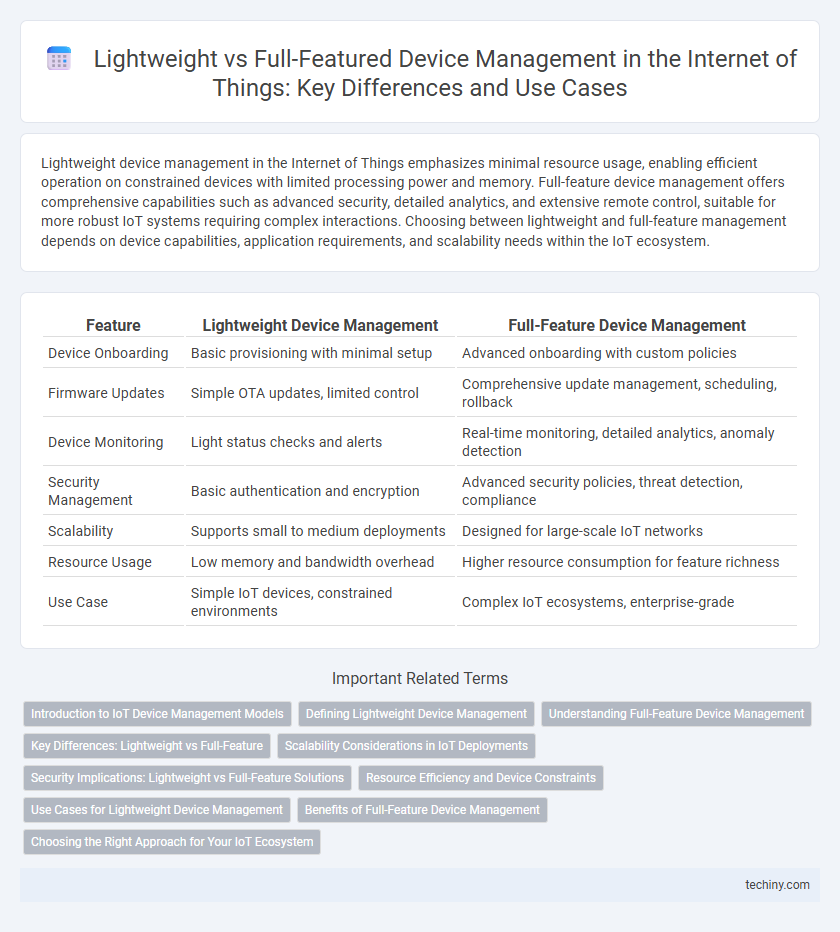Lightweight device management in the Internet of Things emphasizes minimal resource usage, enabling efficient operation on constrained devices with limited processing power and memory. Full-feature device management offers comprehensive capabilities such as advanced security, detailed analytics, and extensive remote control, suitable for more robust IoT systems requiring complex interactions. Choosing between lightweight and full-feature management depends on device capabilities, application requirements, and scalability needs within the IoT ecosystem.
Table of Comparison
| Feature | Lightweight Device Management | Full-Feature Device Management |
|---|---|---|
| Device Onboarding | Basic provisioning with minimal setup | Advanced onboarding with custom policies |
| Firmware Updates | Simple OTA updates, limited control | Comprehensive update management, scheduling, rollback |
| Device Monitoring | Light status checks and alerts | Real-time monitoring, detailed analytics, anomaly detection |
| Security Management | Basic authentication and encryption | Advanced security policies, threat detection, compliance |
| Scalability | Supports small to medium deployments | Designed for large-scale IoT networks |
| Resource Usage | Low memory and bandwidth overhead | Higher resource consumption for feature richness |
| Use Case | Simple IoT devices, constrained environments | Complex IoT ecosystems, enterprise-grade |
Introduction to IoT Device Management Models
Lightweight Device Management models prioritize minimal resource consumption and simplified protocols for efficient operation in constrained IoT environments, enabling scalable deployment of connected devices with limited processing power and bandwidth. Full-Feature Device Management offers comprehensive functionalities such as advanced configuration, real-time monitoring, security enforcement, and firmware updates, suitable for complex applications requiring robust control and high reliability. Choosing the appropriate IoT device management model depends on factors like device capabilities, network conditions, and application requirements to optimize performance and maintenance.
Defining Lightweight Device Management
Lightweight Device Management in the Internet of Things (IoT) refers to streamlined protocols and tools designed to efficiently handle essential device tasks such as configuration, monitoring, and updating with minimal resource consumption. This approach targets constrained environments where devices have limited processing power, memory, and bandwidth, ensuring reliable operation without overburdening the network or endpoints. Emphasizing simplicity and scalability, lightweight management protocols like LWM2M (Lightweight Machine to Machine) enhance device connectivity and maintenance while minimizing operational complexity.
Understanding Full-Feature Device Management
Full-feature device management in the Internet of Things (IoT) provides comprehensive capabilities such as real-time monitoring, remote configuration, firmware updates, and detailed analytics, ensuring enhanced control and security. This approach supports complex device ecosystems with scalability and robust integration options, facilitating seamless interoperability across diverse platforms. Emphasizing full-feature management enables organizations to optimize device performance, automate maintenance, and maintain compliance with evolving industry standards.
Key Differences: Lightweight vs Full-Feature
Lightweight device management in IoT emphasizes minimal resource consumption and simplified protocols for constrained devices, enabling efficient operation with limited CPU, memory, and power. Full-feature device management offers comprehensive capabilities such as advanced security, detailed monitoring, complex configurations, and over-the-air updates, suited for high-end or critical devices. The key differences lie in scalability, complexity, and resource utilization, with lightweight solutions prioritizing minimalism and full-feature solutions prioritizing extensive control and functionality.
Scalability Considerations in IoT Deployments
Lightweight device management optimizes scalability by minimizing resource consumption and simplifying protocols, making it ideal for large-scale IoT deployments with constrained devices. Full-feature device management supports extensive functionalities and robust security, which can introduce overhead that limits scalability in expansive networks. Effective IoT deployment strategies balance the trade-offs between lightweight and full-feature management to ensure seamless scalability and operational efficiency.
Security Implications: Lightweight vs Full-Feature Solutions
Lightweight device management in IoT prioritizes minimal resource consumption, often limiting security functionalities to essential encryption and basic authentication, which reduces attack surfaces but may leave advanced threats unaddressed. Full-feature device management offers comprehensive security measures, including detailed access controls, continuous monitoring, and automated patch management, enhancing protection but requiring more processing power and memory. The trade-off between lightweight and full-feature solutions involves balancing device constraints with the need for robust security protocols to prevent vulnerabilities in IoT deployments.
Resource Efficiency and Device Constraints
Lightweight device management optimizes resource efficiency by minimizing processing power, memory usage, and network bandwidth, making it ideal for IoT devices with strict constraints such as limited battery life and low computational capabilities. Full-feature device management offers comprehensive functionality including advanced security, firmware updates, and detailed diagnostics, but it demands higher resource consumption and may not be suitable for constrained devices. Prioritizing lightweight protocols like CoAP and MQTT enhances scalability and extends device longevity in resource-limited IoT deployments.
Use Cases for Lightweight Device Management
Lightweight device management in the Internet of Things (IoT) is ideal for constrained devices with limited processing power and memory, such as sensors and basic actuators. Use cases include remote firmware updates, simple configuration changes, and basic health monitoring in smart agriculture, industrial monitoring, and smart city deployments. This approach reduces bandwidth consumption and extends battery life, enabling efficient operation in large-scale networks with thousands of low-power devices.
Benefits of Full-Feature Device Management
Full-feature device management in the Internet of Things (IoT) provides comprehensive capabilities such as remote monitoring, real-time diagnostics, secure firmware updates, and advanced analytics that optimize device performance and reliability. This approach ensures enhanced security protocols and centralized control, reducing downtime and enabling proactive maintenance across large-scale deployments. Enterprises benefit from scalable management solutions that improve operational efficiency while maintaining robust device compliance and integration within complex IoT ecosystems.
Choosing the Right Approach for Your IoT Ecosystem
Lightweight device management in IoT offers streamlined protocols and reduced resource consumption, making it ideal for large-scale sensor networks with limited processing power. Full-feature device management provides advanced functionalities such as remote diagnostics, firmware updates, and security configurations, catering to complex devices requiring comprehensive oversight. Selecting the right approach depends on factors like device capability, network constraints, and specific operational requirements to ensure efficient and secure IoT ecosystem management.
Lightweight Device Management vs Full-Feature Device Management Infographic

 techiny.com
techiny.com